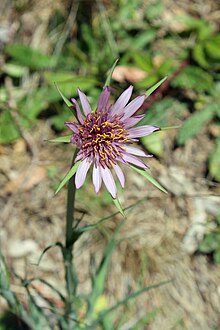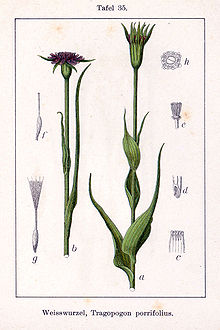
Back لحية التيس كراتي الورق Arabic Salsifí Catalan Tragopogon porrifolius CEB Barf-yr-afr gochlas Welsh Haferwurzel German Λαγόχορτο Greek Tragopogo Esperanto Tragopogon porrifolius Spanish Terebuzu Basque شنگ ترهای Persian
| Tragopogon porrifolius | |
|---|---|

| |
| Scientific classification | |
| Kingdom: | Plantae |
| Clade: | Tracheophytes |
| Clade: | Angiosperms |
| Clade: | Eudicots |
| Clade: | Asterids |
| Order: | Asterales |
| Family: | Asteraceae |
| Genus: | Tragopogon |
| Species: | T. porrifolius
|
| Binomial name | |
| Tragopogon porrifolius | |
| Synonyms[2] | |
| |
| Nutritional value per 100 g (3.5 oz) | |
|---|---|
| Energy | 343 kJ (82 kcal) |
18.6 g | |
| Dietary fiber | 3.3 g |
0.2 g | |
3.3 g | |
| Vitamins | Quantity %DV† |
| Thiamine (B1) | 7% 0.08 mg |
| Riboflavin (B2) | 17% 0.22 mg |
| Niacin (B3) | 3% 0.5 mg |
| Pantothenic acid (B5) | 7% 0.371 mg |
| Vitamin B6 | 16% 0.277 mg |
| Folate (B9) | 7% 26 μg |
| Vitamin C | 9% 8 mg |
| Minerals | Quantity %DV† |
| Calcium | 5% 60 mg |
| Iron | 4% 0.7 mg |
| Magnesium | 5% 23 mg |
| Manganese | 12% 0.268 mg |
| Phosphorus | 6% 75 mg |
| Potassium | 13% 380 mg |
| Sodium | 1% 20 mg |
| Zinc | 3% 0.38 mg |
| Other constituents | Quantity |
| Water | 77 g |
| †Percentages estimated using US recommendations for adults,[3] except for potassium, which is estimated based on expert recommendation from the National Academies.[4] | |


Tragopogon porrifolius is a plant cultivated for its ornamental flower and edible root. It also grows wild in many places and is one of the most widely known species of the salsify genus, Tragopogon. It is commonly known as purple or common salsify, oyster plant, vegetable oyster, Jerusalem star,[5] Jack go to bed,[6] or simply salsify (although these last two names are also applied to other species).
The Latin specific epithet porrifolius means "with leaves like leek" (Allium porrum).[7]
- ^ Species Plantarum 2: 789. 1753. "Name – Tragopogon L." Tropicos. Saint Louis, Missouri: Missouri Botanical Garden. Retrieved February 8, 2010.
Type Specimens: Tragopogon porrifolius
- ^ The Plant List: A Working List of All Plant Species, retrieved 1 July 2016
- ^ United States Food and Drug Administration (2024). "Daily Value on the Nutrition and Supplement Facts Labels". FDA. Archived from the original on 2024-03-27. Retrieved 2024-03-28.
- ^ National Academies of Sciences, Engineering, and Medicine; Health and Medicine Division; Food and Nutrition Board; Committee to Review the Dietary Reference Intakes for Sodium and Potassium (2019). Oria, Maria; Harrison, Meghan; Stallings, Virginia A. (eds.). Dietary Reference Intakes for Sodium and Potassium. The National Academies Collection: Reports funded by National Institutes of Health. Washington, DC: National Academies Press (US). ISBN 978-0-309-48834-1. PMID 30844154. Archived from the original on 2024-05-09. Retrieved 2024-06-21.
- ^ "J". Historical Common Names of Great Plains Plants. University of Nebraska-Lincoln. Archived from the original on December 7, 2009. Retrieved March 9, 2010.
- ^ Storl, Wolf-Dieter (2012). Bekannte und vergessene Gemüse : Ethnobotanik, Heilkunde und Anwendungen. Aarau: AT Verlag. ISBN 978-3-03800-672-5.
- ^ Harrison, Lorraine (2012). RHS Latin for Gardeners. United Kingdom: Mitchell Beazley. ISBN 978-1845337315.
© MMXXIII Rich X Search. We shall prevail. All rights reserved. Rich X Search